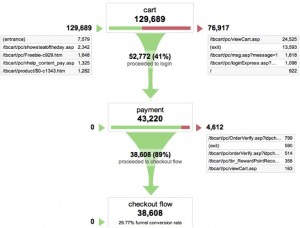 Small changes to your website could result in hundreds of thousands of dollars in incremental revenue.
Small changes to your website could result in hundreds of thousands of dollars in incremental revenue.
I recently took part in a webinar sponsored by the American Marketing Association entitled: Keys to Website Success. I was curious to learn what Lance Loveday, CEO Closed Loop Marketing would choose to spotlight for this particular topic, which is so vast. I was pleasantly surprised to hear his top 7 picks, which I do believe are definitely worth focusing on – let me summarize them here:
7 Keys to Website Success:
- Little changes to your website’s design, visual hierarchy, calls to action, copy, etc. make a huge difference
- Focus on what people do (usability testing), not what they say (surveys)
- Follow the money by translating metrics into dollars
- Focus on trends over a broad timeline, not short-term data snapshots
- Be persistent with website optimization efforts – it’s a continual tweaking process
- Close the loop by tracking lead source through to final sale
- Triangulate with different types of metrics (usability data, web analytics, sales metrics, etc.)
This all sounds logical and is very prudent advice. So, why is it that many companies are not following these basic principles?
I have been consulting on several projects for half a dozen eCommerce clients in Australia, analyzing the effectiveness of their online sales funnel process in reaching their desired business goals.
All of these companies are online retailers and they get the majority of their customers via the Internet, so it’s not surprising that they all have similar goals:
- Grow revenue and increase profitability by lifting conversion rates (from clicks to desired action) and shrinking cost per lead acquisition.
- Increase traffic to the website and gain new customers.
All of these eTailers also have similar website statistics:
- Many of them don’t have proper website analytics in place to track data, which is necessary for understanding trends and translating metrics into dollars
- Bounce rates and unsubscribe rates are extremely high, and little attempt is made to understand ‘why’, resulting in non existent customer retention strategies
- Conversion rates are low, with numerous missed opportunities for improvement
- Shopping cart abandonment is frighteningly high and no attempts are made to recover lost revenues due to cart abandonment
If these eTailers had a brick and mortar store and their front door was blocked, they would get it fixed quickly. They would also invest money in determining the most effective store layout to facilitate customer flow through the store, best positioning of merchandise within the store, directional signage, etc. Why don’t we value the same forms of ‘store optimization’ on the web?
Why would a business choose to spend more time, money and resources increasing website traffic (goal #2 above) when the website is not fully optimized to convert and retain the hundreds of thousands of visitors who are ALREADY coming to the site every month, for which they’ve paid for?
Consider these three statistics (based on actual tests conducted):
- Taking a phased approach (long-term view) to website optimization could double your conversion rates over time. (Source: Closed Loop Marketing)
- Making small changes to your shopping cart process such as on-page copy, visual hierarchy and call to action buttons could increase conversions by 10%, which could translate into hundreds of thousands of dollars in incremental revenue. (Source: Closed Loop Marketing)
- Nurturing a customer relationship after a lost sale could lead to a 50% recovery of revenue in just one year. (Source: Internet Moguls)
eBusinesses need website traffic in order to survive and they could spend all the money in the world to advertise their company and get billions of visits each month. However, if they can’t convert those visits into paying customers and keep them over the long term, this is not only a very inefficient marketing investment but also an exercise in lost revenue opportunities.
Why do we seem more prepared to live with poor visitor flow on a commercial web site than we would in a physical store? Please share your comments below.
